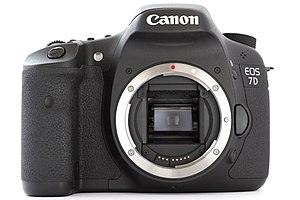 | |
| Overview | |
|---|---|
| Type | Digital single-lens reflex camera |
| Intro price | $1699.00[1] |
| Lens | |
| Lens | Interchangeable (EF, EF-S) |
| Sensor/medium | |
| Sensor | 22.3 × 14.9 mm CMOS |
| Maximum resolution | 5,184 × 3,456 (18 effective megapixels) |
| Film speed | 100–6400 (expansion up to 12,800) |
| Storage media | CompactFlash (CF) (Type I or Type II) |
| Focusing | |
| Focus modes | One-shot, AI Servo, AI Focus, Manual |
| Focus areas | 19 cross-type AF points |
| Exposure/metering | |
| Exposure modes | Full auto, programmed, shutter priority, aperture priority, manual |
| Exposure metering | TTL, full aperture, 63 zones |
| Metering modes | Evaluative, Partial, Spot, C/Wgt Average |
| Shutter | |
| Shutter | Electronic focal-plane |
| Shutter speed range | 30s to 1/8000 s Bulb |
| Continuous shooting | up to 8.0 frame/s |
| Viewfinder | |
| Viewfinder | Optical pentaprism with 1.0x magnification (with 50mm lens) and 100% coverage and electronic (Live View) |
| General | |
| LCD screen | 3.0 inches (76 mm), 640×480 (921,600 dots) |
| Battery | Li-Ion LP-E6 Rechargeable (1800mAh) |
| Optional battery packs | BG-E7 grip allows use of 6 AA cells, a single LP-E6 or two LP-E6 batteries |
| Weight | 820 g (body only) |
| Made in | Japan |
| Chronology | |
| Successor | Canon EOS 7D Mark II |
The Canon EOS 7D is a high-end APS-C digital single-lens reflex camera made by Canon.[2] It was announced on 1 September 2009 with a suggested retail price of US$1,699, and was marketed as a semi-professional DSLR camera.[1][3]
Among its features are an 18.0 effective megapixel CMOS sensor, Full HD video recording, its 8.0 frames per second continuous shooting, new viewfinder which offers 1.0X magnification and 100% coverage, 19-point auto-focus system, movie mode, and built-in Speedlite transmitter.[2]
The EOS 7D remained in Canon's single-digit APS-C model lineup without replacement for slightly more than five years—the longest product cycle for any EOS digital camera.[4] Its successor was the Canon EOS 7D Mark II, announced on 15 September 2014.
- ^ a b "Canon EOS 7D Camera - Full Review". Imaging-resource.com. Retrieved 18 May 2012.
- ^ a b "EOS 7D product page at canon.com". Usa.canon.com. 25 May 2006. Retrieved 9 May 2017.
- ^ "Canon introduces the EOS 7D..." (Press release). Canon UK. 1 September 2009. Retrieved 4 December 2009.
- ^ Carnathan, Bryan. "Canon EOS 7D Mark II Review". The-Digital-Picture.com. Retrieved 5 February 2015.